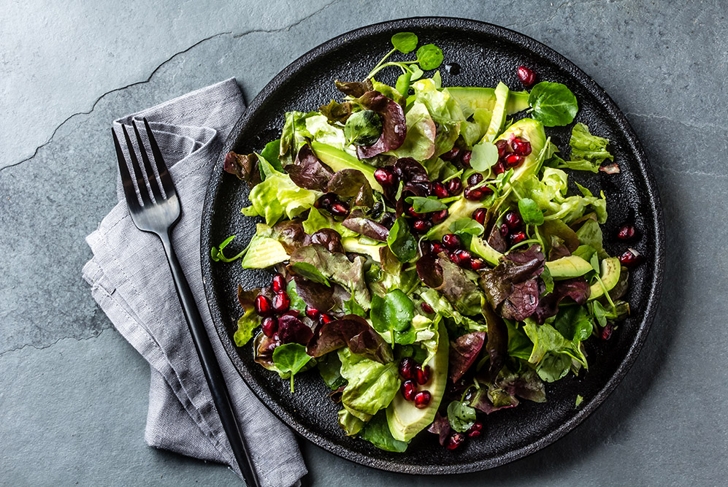
Ancient Greeks believed it made them smarter and it has even been rumoured to cure a hangover. The health benefits of watercress have been revered for millenia.
Irish monks considered it pure food for the sages, ancient Greeks believed eating it made them smarter, and at times it has even been rumoured to cure a hangover.
One of the first leafy greens consumed by humans, the health-promoting properties of watercress have been revered for millennia. Packed full of essential nutrients and disease-fighting antioxidants, watercress’s healthy reputation comes as no surprise.
What exactly is it?

Watercress is a member of the cruciferous vegetable family. Like other cruciferous vegetables such as broccoli and kale, when chewed or chopped, watercress releases a variety of phytochemicals that are thought to ward off cancer.
While all cruciferous vegetables are good sources of these cancer-fighting plant compounds, watercress is uniquely abundant in one in particular, phenylethyl isothiocyanate (PEITC). Evidence is mounting to suggest PEITC may provide strong protection against cancer by interfering with tumour development.
A powerful cancer fighter

When breast tumours outgrow their blood supply, they send a message via a protein called hypoxia inducible factor (HIF) that signals surrounding healthy tissue to feed them the nutrients they need. This process is thought to be a critical step in the transformation of a dormant tumour into a cancerous one.
Researchers from the University of Southampton found that when breast cancer survivors ate a cereal-sized bowl (80 g) of watercress, HIF’s ability to deliver its message was significantly reduced. The high levels of PEITC found in watercress are credited for this potentially tumour-inhibiting effect.
Expanding the cancer-fighting potential

Although evidence is still preliminary, PEITC is also showing promise in warding off cancer in other areas of the body including the prostate, lung, and colon.
In one laboratory study, researchers from New York Medical College found PEITC was able to inhibit rapid cell division, slow tumour development, and cause death in human prostate cancer cells.
Researchers from Georgetown University Medical Center also found PEITC to work in a similar fashion to protect mice from developing both benign and cancerous tumours in the lungs after being exposed to tobacco carcinogens.
And in another study, funded by the National Institutes of Health, this cancer-fighting plant compound was shown to make changes at a cellular level to reduce chronic inflammation in the colon, effectively reducing symptoms associated with ulcerative colitis—considered a major risk factor in the development of colon cancer.
Antioxidant dense

PEITC isn’t watercress’s only disease-fighting compound. Rich in dietary antioxidants such as vitamins A and C, watercress may also help to ward off chronic disease by protecting cells from damaging free radicals.
A study published in the American Journal of Clinical Nutrition found that when eaten regularly, watercress may significantly reduce free-radical damage to immune-boosting white blood cells. During the study 60 healthy men and women ate an 85 g bag of fresh watercress daily. After eight weeks the researchers found that DNA damage to the participants’ white blood cells had been reduced on average by 23.9 percent.
Aiding the arteries

In addition to protecting the participants from free-radical damage, the daily dose of watercress was found by the researchers to have reduced artery-clogging blood triglyceride levels by 10 percent and significantly increased levels of other antioxidant compounds such as lutein and beta carotene.
High blood levels of lutein in combination with zeaxanthin have been linked to a lower risk of age-related macular degeneration. Containing over 1,900 mcg of lutein and zeaxanthin in a one cup (48 g) serving, raw watercress is an excellent source of these two eye-healthy carotenoids.
Promotes healthy bones and heart

The nutritional merits of watercress don’t stop there. Watercress is also a good source of bone-strengthening vitamin K, calcium, and folic acid.
Just one cup (48 g) of raw watercress provides 106 percent of the recommended daily value of vitamin K, needed by bones to properly process calcium. Diets high in vitamin K have been linked to greater bone density and a reduced risk of bone fractures in postmenopausal women.
Folic acid-friendly

Folic acid, although better known for its role in promoting a healthy pregnancy, also helps to keep homocysteine levels under control. Homocysteine is an amino acid that in high amounts is associated with an increased risk of bone fractures. In one study researchers found that participants who had high amounts of homocysteine in their blood were nearly two times more likely to break a bone, regardless of bone density.
The high folic acid content of watercress not only strengthens the bones, but also may protect the heart. Preliminary research has associated elevated levels of homocysteine with blood vessel damage and an increased risk of heart disease and stroke.
From promoting strong bones to warding off cancer, watercress is certainly one healthy leafy green to eat often.
Take advantage

Although best known for its place at English afternoon tea, watercress makes a tasty addition to a wide array of dishes. Available year round, it is easy to take advantage of all the health-protecting properties watercress has to offer by including it as part of your regular diet.
Try it
In place of lettuce
Watercress makes a tasty substitution for lettuce or spinach in a salad or sandwich.
At breakfast
Throw a handful of chopped watercress into your favourite omelette or scrambled egg recipe. Mix it with cream cheese to make a healthy spread for your toast or bagel.
Puréed
Purée it with boiled potatoes and peas to make a nutritious, low-calorie creamy soup.
As a pizza topping
Make a bland pizza gourmet by topping it with chopped watercress and basil.
On pasta
Use it to add a bit of spice to a marinara sauce or use in place of basil in a pesto recipe.
In a smoothie
A few sprigs add an eye-catching green hue as well as a good dose of disease-fighting antioxidants to a traditional fruit smoothie.




